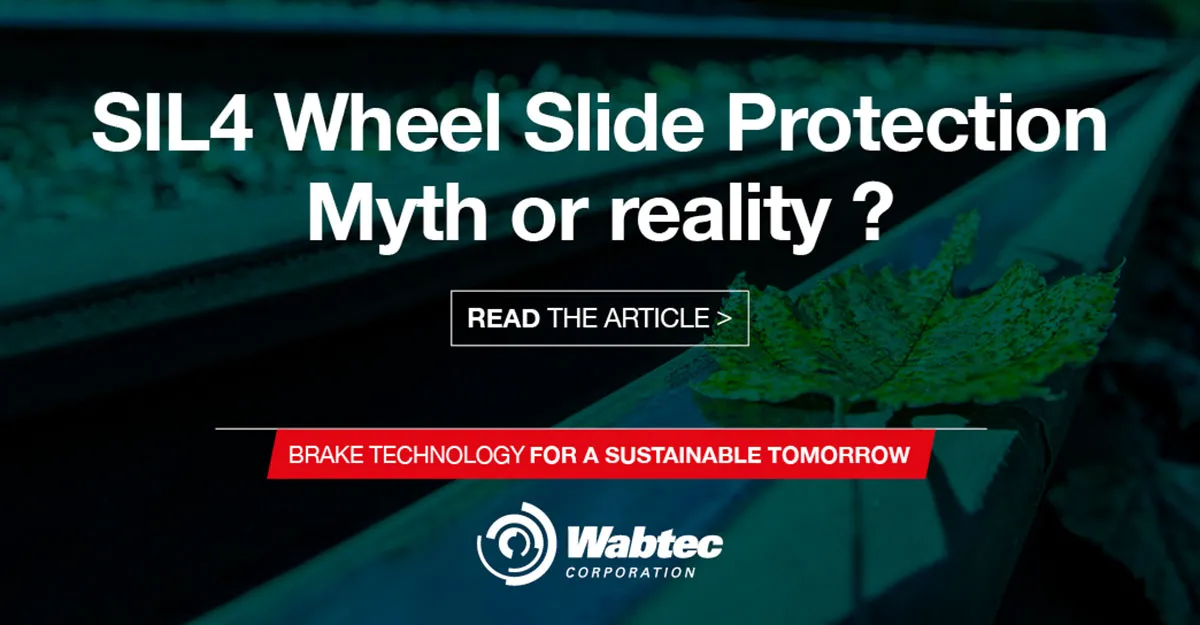In rail transportation, wheel slide protection systems (WSP) manage the delicate wheel-to-rail adhesion issue. In dry situations, the adhesion between the steel wheel and the steel rail is already low by nature. This available adhesion represents the physical limit of the train’s braking performance. External factors such as rain, ice, fallen leaves, pollution or contamination with oil or grease can further reduce available adhesion. For this reason, rail brake suppliers have, for many years now, developed wheel slide protection systems. These systems monitor the rotation speed of the four axles of the vehicle in real time, calculating average vehicle speed and axle rotational speed variation. Each time the system detects an axle sliding, the wheel slide protection adjusts the pressure in the corresponding brake cylinder(s) to ensure the axle doesn’t lock, avoiding the risk of a wheel flat, a potential safety issue in train operations. The system ensures that each axle will use available adhesion to generate braking force.
In the scenario above, there is a risk that one or more axles can remain in a brake released status if there are any failures in the wheel slide protection control or if adhesion is very low. Obviously, releasing the brake isn’t safe. That’s why all wheel slide protection systems include an independent watchdog (WD) function that reapplies full brake effort if the brake release commanded by the wheel slide protection is longer than a set time (often 10 seconds). Ultimately, it means that applying the brake and risking full axle slide is preferred to no braking at all.
This watchdog function is key to ensuring the safety in traditional wheel slide protection systems. The watchdog is an independent hardware device that leaves the WSP function deactivated once it has been triggered.
In reality, the first generation of WSP systems avoided axle slide by fully releasing brake effort when slide was detected. The drawback of this type of system was a dramatic braking distance increase in degraded adhesion.
The second generation of WSP systems (introduced in the ‘90s) is capable of fully managing the slide of each axle, enabling the best use of available adhesion. Thanks to this, braking distance in degraded adhesion is greatly reduced, contributing to higher train operation safety.
Still, some of the operators would like to see higher safety level for wheel slide protection system especially when used in Emergency brake.
When we developed our integrated brake control Metroflexx & Regioflexx family, we used dual electronic architecture. One Safety Integrity Level 2 (SIL 2) unit performs the usual Brake Control Unit (BCU) function, and one SIL 4 unit – with SIL 4 hardware and software – performs monitoring and redundancy functions. This specific electronic architecture has created new opportunities to reinforce the safety of the wheel slide protection system:
- A SIL 4 monitoring function that continuously monitors the wheel slide protection by checking the behaviour of each axle (speed, deceleration, etc.) and manages brake effort to obtain optimal deceleration with available adhesion in real time.
- A fully SIL 4-certified watchdog function. The traditional watchdog function remains active, but WSP monitoring prevents its activation through fast, highly accurate control. WSP monitoring therefore significantly reduces the risk of axle lock/wheel flat in very low adhesion conditions, improving train safety and availability.
- An integrated SIL4 wheel rotation monitoring (WRM) function for very high-speed application is available, enabling massive system simplification for both the car builder (initial cost) and the operator (maintenance cost).
The market reaction to the reinforced safety and performance of wheel slide protection systems has been so positive that we have decided to offer the same technology on traditional braking systems, using separate BCUs and pneumatics. We developed the SIL 4 Wise™ board to be integrated into our traditional Gemini II brake control unit (BCU). Wise™ is a fully independent, dedicated SIL 4 hardware and software solution that uses its own power supply.
With Wise™ inserted in a traditional brake control unit (BCU), the wheel slide protection system in your train will include:
- Our UIC-approved AEF91 wheel slide protection algorithm, or DistanceMaster™ adaptive wheel slide protection
- A certified SIL 4 watchdog function
- A SIL 4 monitoring function that provides stronger resilience in very low adhesion conditions and better train safety & availability
- Embedded SIL 4 wheel rotation monitoring (WRM) should your train require it (speed > 200 km/h)
When equipped with Wise™, your train can use wheel slide protection when emergency braking without any safety concern, thanks to its SIL 4 watchdog function. The SIL 4 wheel slide protection monitoring function can make your train much more resilient in very low adhesion conditions. In addition, maintenance cost can be greatly reduced due to better energy management at wheel/rail contact point energy.
So, back to the initial question about SIL 4 wheel slide protection: myth or reality? It will certainly remain a myth for most market players for the time being. But for Wabtec and our Wise™ electronics, it’s already a reality, with proven design and benefits.
Looking for more information on SIL 4 wheel slide protection systems and Wise™ electronics? Contact us at: brakesandcouplers [at] wabtec [dot] com
